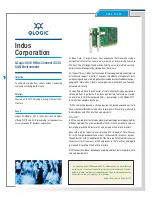Mixed-Signal ISP Flash MCU
C8051F330/1/2/3/4/5
Rev. 1.7 12/10
Copyright © 2010 by Silicon Laboratories
C8051F330/1/2/3/4/5
Analog Peripherals
-
10-Bit ADC (‘F330/2/4 only)
•
Up to 200 ksps
•
Up to 16 external single-ended or differential inputs
•
VREF from internal VREF, external pin or V
DD
•
Internal or external start of conversion source
•
Built-in temperature sensor
-
10-Bit Current Output DAC (‘F330 only)
-
Comparator
•
Programmable hysteresis and response time
•
Configurable as interrupt or reset source
•
Low current (0.4 µA)
On-Chip Debug
-
On-chip debug circuitry facilitates full speed, non-
intrusive in-system debug (no emulator required)
-
Provides breakpoints, single stepping,
inspect/modify memory and registers
-
Superior performance to emulation systems using
ICE-chips, target pods, and sockets
-
Low cost,
complete
development kit
Supply Voltage 2.7 to 3.6 V
-
Typical operating current: 6.4 mA at 25 MHz;
9 µA at 32 kHz
-
Typical stop mode current: 0.1 µA
Temperature Range: –40 to +85 °C
High Speed 8051 µC Core
-
Pipelined instruction architecture; executes 70% of
instructions in 1 or 2 system clocks
-
Up to 25 MIPS throughput with 25 MHz clock
-
Expanded interrupt handler
Memory
-
768 bytes internal data RAM (256 + 512)
-
8 kB (‘F330/1), 4 kB (‘F332/3), or 2 kB (‘F334/5)
Flash; In-system programmable in 512-byte Sec-
tors—512 bytes are reserved in the 8 kB devices
Digital Peripherals
-
17 Port I/O; All 5 V tolerant with high sink current
-
Hardware enhanced UART, SMBus™, and
enhanced SPI™ serial ports
-
Four general purpose 16-bit counter/timers
-
16-Bit programmable counter array (PCA) with three
capture/compare modules
-
Real time clock mode using PCA or timer and exter-
nal clock source
Clock Sources
-
Two internal oscillators:
•
24.5 MHz with ±2% accuracy supports crystal-less
UART operation
•
80/40/20/10 kHz low frequency, low power
-
External oscillator: Crystal, RC, C, or clock
(1 or 2 pin modes)
-
Can switch between clock sources on-the-fly; useful
in power saving modes
20-Pin QFN Package
ANALOG
PERIPHERALS
2/4/8 kB
ISP FLASH
768 B SRAM
POR
DEBUG
CIRCUITRY
FLEXIBLE
INTERRUPTS
8051 CPU
(25 MIPS)
DIGITAL I/O
24.5 MHz PRECISION
INTERNAL OSCILLATOR
HIGH-SPEED CONTROLLER CORE
CR
OSSBAR
VOLTAGE
COMPARATOR
+
-
WDT
UART
SMBus
PCA
Timer 0
Timer 1
Timer 2
Timer 3
Port 0
SPI
10-bit
Current
DAC
LOW FREQUENCY INTERNAL
OSCILLATOR
Port 1
P2.0
10-bit
200 ksps
ADC
TEMP
SENSOR
A
M
U
X
‘F330/2/4 only
‘F330 only
Summary of Contents for TOOLSTICK C8051F330
Page 2: ...C8051F330 1 2 3 4 5 2 Rev 1 7 ...
Page 10: ...C8051F330 1 2 3 4 5 10 Rev 1 7 ...
Page 16: ...C8051F330 1 2 3 4 5 16 Rev 1 7 ...
Page 40: ...C8051F330 1 2 3 4 5 40 Rev 1 7 ...
Page 56: ...C8051F330 1 2 3 4 5 56 Rev 1 7 ...
Page 64: ...C8051F330 1 2 3 4 5 64 Rev 1 7 ...
Page 96: ...C8051F330 1 2 3 4 5 96 Rev 1 7 ...
Page 110: ...C8051F330 1 2 3 4 5 110 Rev 1 7 ...
Page 112: ...C8051F330 1 2 3 4 5 112 Rev 1 7 ...
Page 176: ...C8051F330 1 2 3 4 5 176 Rev 1 7 ...


















